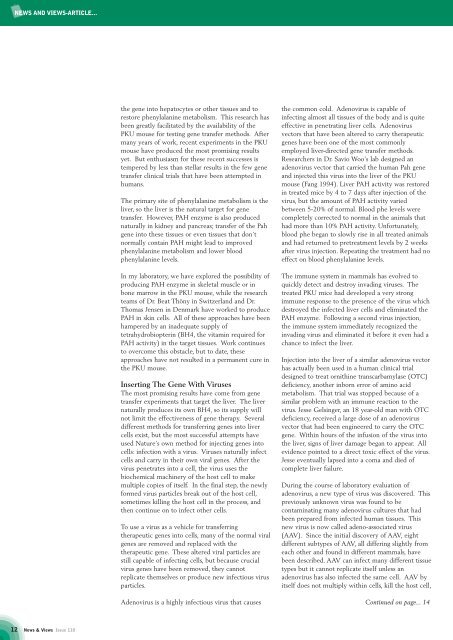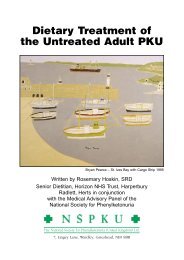N&V 110.pdf - NSPKU
N&V 110.pdf - NSPKU
N&V 110.pdf - NSPKU
You also want an ePaper? Increase the reach of your titles
YUMPU automatically turns print PDFs into web optimized ePapers that Google loves.
NEWS AND VIEWS-ARTICLE...<br />
the gene into hepatocytes or other tissues and to<br />
restore phenylalanine metabolism. This research has<br />
been greatly facilitated by the availability of the<br />
PKU mouse for testing gene transfer methods. After<br />
many years of work, recent experiments in the PKU<br />
mouse have produced the most promising results<br />
yet. But enthusiasm for these recent successes is<br />
tempered by less than stellar results in the few gene<br />
transfer clinical trials that have been attempted in<br />
humans.<br />
The primary site of phenylalanine metabolism is the<br />
liver, so the liver is the natural target for gene<br />
transfer. However, PAH enzyme is also produced<br />
naturally in kidney and pancreas; transfer of the Pah<br />
gene into these tissues or even tissues that don’t<br />
normally contain PAH might lead to improved<br />
phenylalanine metabolism and lower blood<br />
phenylalanine levels.<br />
In my laboratory, we have explored the possibility of<br />
producing PAH enzyme in skeletal muscle or in<br />
bone marrow in the PKU mouse, while the research<br />
teams of Dr. Beat Thöny in Switzerland and Dr.<br />
Thomas Jensen in Denmark have worked to produce<br />
PAH in skin cells. All of these approaches have been<br />
hampered by an inadequate supply of<br />
tetrahydrobiopterin (BH4, the vitamin required for<br />
PAH activity) in the target tissues. Work continues<br />
to overcome this obstacle, but to date, these<br />
approaches have not resulted in a permanent cure in<br />
the PKU mouse.<br />
Inserting The Gene With Viruses<br />
The most promising results have come from gene<br />
transfer experiments that target the liver. The liver<br />
naturally produces its own BH4, so its supply will<br />
not limit the effectiveness of gene therapy. Several<br />
different methods for transferring genes into liver<br />
cells exist, but the most successful attempts have<br />
used Nature’s own method for injecting genes into<br />
cells: infection with a virus. Viruses naturally infect<br />
cells and carry in their own viral genes. After the<br />
virus penetrates into a cell, the virus uses the<br />
biochemical machinery of the host cell to make<br />
multiple copies of itself. In the final step, the newly<br />
formed virus particles break out of the host cell,<br />
sometimes killing the host cell in the process, and<br />
then continue on to infect other cells.<br />
To use a virus as a vehicle for transferring<br />
therapeutic genes into cells, many of the normal viral<br />
genes are removed and replaced with the<br />
therapeutic gene. These altered viral particles are<br />
still capable of infecting cells, but because crucial<br />
virus genes have been removed, they cannot<br />
replicate themselves or produce new infectious virus<br />
particles.<br />
Adenovirus is a highly infectious virus that causes<br />
the common cold. Adenovirus is capable of<br />
infecting almost all tissues of the body and is quite<br />
effective in penetrating liver cells. Adenovirus<br />
vectors that have been altered to carry therapeutic<br />
genes have been one of the most commonly<br />
employed liver-directed gene transfer methods.<br />
Researchers in Dr. Savio Woo’s lab designed an<br />
adenovirus vector that carried the human Pah gene<br />
and injected this virus into the liver of the PKU<br />
mouse (Fang 1994). Liver PAH activity was restored<br />
in treated mice by 4 to 7 days after injection of the<br />
virus, but the amount of PAH activity varied<br />
between 5-20% of normal. Blood phe levels were<br />
completely corrected to normal in the animals that<br />
had more than 10% PAH activity. Unfortunately,<br />
blood phe began to slowly rise in all treated animals<br />
and had returned to pretreatment levels by 2 weeks<br />
after virus injection. Repeating the treatment had no<br />
effect on blood phenylalanine levels.<br />
The immune system in mammals has evolved to<br />
quickly detect and destroy invading viruses. The<br />
treated PKU mice had developed a very strong<br />
immune response to the presence of the virus which<br />
destroyed the infected liver cells and eliminated the<br />
PAH enzyme. Following a second virus injection,<br />
the immune system immediately recognized the<br />
invading virus and eliminated it before it even had a<br />
chance to infect the liver.<br />
Injection into the liver of a similar adenovirus vector<br />
has actually been used in a human clinical trial<br />
designed to treat ornithine transcarbamylase (OTC)<br />
deficiency, another inborn error of amino acid<br />
metabolism. That trial was stopped because of a<br />
similar problem with an immune reaction to the<br />
virus. Jesse Gelsinger, an 18 year-old man with OTC<br />
deficiency, received a large dose of an adenovirus<br />
vector that had been engineered to carry the OTC<br />
gene. Within hours of the infusion of the virus into<br />
the liver, signs of liver damage began to appear. All<br />
evidence pointed to a direct toxic effect of the virus.<br />
Jesse eventually lapsed into a coma and died of<br />
complete liver failure.<br />
During the course of laboratory evaluation of<br />
adenovirus, a new type of virus was discovered. This<br />
previously unknown virus was found to be<br />
contaminating many adenovirus cultures that had<br />
been prepared from infected human tissues. This<br />
new virus is now called adeno-associated virus<br />
(AAV). Since the initial discovery of AAV, eight<br />
different subtypes of AAV, all differing slightly from<br />
each other and found in different mammals, have<br />
been described. AAV can infect many different tissue<br />
types but it cannot replicate itself unless an<br />
adenovirus has also infected the same cell. AAV by<br />
itself does not multiply within cells, kill the host cell,<br />
Continued on page... 14<br />
12 News & Views Issue 110
















